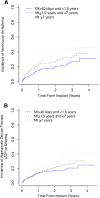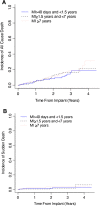Influence of time between last myocardial infarction and prophylactic implantable defibrillator implant on device detections and therapies. "Routine Practice" data from the SEARCH MI registry
- PMID: 22966862
- PMCID: PMC3504521
- DOI: 10.1186/1471-2261-12-72
Influence of time between last myocardial infarction and prophylactic implantable defibrillator implant on device detections and therapies. "Routine Practice" data from the SEARCH MI registry
Abstract
Background: A multicenter European Registry, SEARCH-MI, was instituted in the year 2002 in order to assess patients' outcomes and ICD interventions in patients with a previous MI and depressed LV function, treated with an ICD according to MADIT II results. In this analysis, we evaluate the influence of the time elapsed between last myocardial infarction (MI) and prophylactic cardioverter defibrillator (ICD) implant on device activations.
Methods: 643 patients with left ventricular dysfunction (mean LVEF 26 ± 5%) and NYHA class I-III were prospectively followed for 1.8 ± 1.2 years in a multicenter registry. The population was divided into 3 groups according to the time between last MI and ICD implant: [1] from 40 days to less than 1.5 years; [2] from 1.5 to less than 7 years and [3] at least 7 years.
Results: The cumulative incidence of ventricular tachyarrhymias and appropriate device therapy (ATP or shock) were higher in patients implanted longer time from last MI (Gray's Test p=0.002 and p=0.013 respectively). No significant differences were seen in all cause mortality (Gray's Test p=0.618) or sudden cardiac death across the MI stratification groups (Gray's Test p=0.663).
Conclusions: Patients implanted with an ICD longer after the MI have a higher chance of presenting ventricular tachyarrhythmias and appropriate ICD therapy, while no differences were seen in overall mortality. These observations may be important for improving patient targeting in sudden death prevention.
Figures


Similar articles
-
Mortality Implications of Appropriate Implantable Cardioverter Defibrillator Therapy in Secondary Prevention Patients: Contrasting Mortality in Primary Prevention Patients From a Prospective Population-Based Registry.J Am Heart Assoc. 2017 Aug 19;6(8):e006220. doi: 10.1161/JAHA.117.006220. J Am Heart Assoc. 2017. PMID: 28862957 Free PMC article.
-
Implantable cardioverter-defibrillators in patients with CKD: a propensity-matched mortality analysis.Clin J Am Soc Nephrol. 2015 Jul 7;10(7):1119-27. doi: 10.2215/CJN.11121114. Epub 2015 Jun 25. Clin J Am Soc Nephrol. 2015. PMID: 26111859 Free PMC article.
-
Outcomes After Implantable Cardioverter-Defibrillator Generator Replacement for Primary Prevention of Sudden Cardiac Death.Circ Arrhythm Electrophysiol. 2016 Mar;9(3):e003283. doi: 10.1161/CIRCEP.115.003283. Circ Arrhythm Electrophysiol. 2016. PMID: 26921377 Free PMC article.
-
When to consider an implantable cardioverter defibrillator following myocardial infarction?Heart. 2015 Dec;101(24):1996-2000. doi: 10.1136/heartjnl-2015-307788. Epub 2015 Nov 2. Heart. 2015. PMID: 26526420 Review.
-
Ongoing Risk of Ventricular Arrhythmias and All-Cause Mortality at Implantable Cardioverter Defibrillator Generator Change: A Systematic Review and Meta-Analysis.Circ Arrhythm Electrophysiol. 2021 Mar;14(3):e009139. doi: 10.1161/CIRCEP.120.009139. Epub 2021 Feb 6. Circ Arrhythm Electrophysiol. 2021. PMID: 33554611
Cited by
-
Clinical valuation of ST changes in a group of patients with ventricular arrhythmias: The inSighT Study.Ann Noninvasive Electrocardiol. 2022 May;27(3):e12914. doi: 10.1111/anec.12914. Epub 2022 Feb 15. Ann Noninvasive Electrocardiol. 2022. PMID: 35170151 Free PMC article.
-
Roles and indications for use of implantable defibrillator and resynchronization therapy in the prevention of sudden cardiac death in heart failure.Heart Fail Rev. 2016 Jul;21(4):433-46. doi: 10.1007/s10741-016-9542-y. Heart Fail Rev. 2016. PMID: 26910804 Review.
References
-
- Moss AJ, Hall WJ, Cannom DS, Daubert JP, Higgins SL, Klein H, Levine JH, Saksena S, Waldo AL, Wilber D, Brown MW, Heo M. Improved survival with an implanted defibrillator in patients with coronary disease at high risk for ventricular arrhythmia. Multicenter Automatic Defibrillator Implantation Trial Investigators. N Engl J Med. 1996;335:1933–1940. doi: 10.1056/NEJM199612263352601. - DOI - PubMed
-
- Bardy GH, Lee KL, Mark DB, Poole JE, Packer DL, Boineau R, Domanski M, Troutman C, Anderson J, Johnson G, McNulty SE, Clapp-Channing N, Davidson-Ray LD, Fraulo ES, Fishbein DP, Luceri RM, Ip JH. Amiodarone or an implantable cardioverter-defibrillator for congestive heart failure. N Engl J Med. 2005;352:225–237. doi: 10.1056/NEJMoa043399. - DOI - PubMed
-
- Ezekowitz JA, Rowe BH, Dryden DM, Hooton N, Vandermeer B, Spooner C, McAlister FA. Systematic review: implantable cardioverter defibrillators for adults with left ventricular systolic dysfunction. Ann Intern Med. 2007;147:251–262. - PubMed
-
- Boriani G, Ricci R, Toselli T, Ferrari R, Branzi A, Santini M. Implantable cardioverter defibrillators: from evidence of trials to clinical practice. Eur Heart J. 2007;9(Suppl I):I66–I73. doi: 10.1093/eurheartj/sum060. - DOI
Publication types
MeSH terms
LinkOut - more resources
Full Text Sources
Medical

